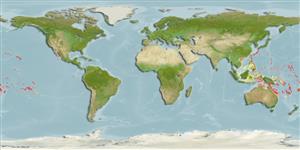Common names from other countries
Environment: milieu / climate zone / depth range / distribution range
Ecologia
marino associati a barriera corallina; distribuzione batimetrica 1 - 10 m (Ref. 9710). Tropical; 30°N - 28°S
Pacific Ocean: Ryukyu Islands to the Line Islands and Mangaréva, south to the Great Barrier Reef and the Austral Islands; Caroline, Mariana, and the Wake islands in Micronesia.
Size / Peso / Age
Maturity: Lm ? range ? - ? cm
Max length : 9.0 cm TL maschio/sesso non determinato; (Ref. 559)
Short description
Chiavi di identificazione | Morfologia | Morfometria
Spine dorsali (totale) : 10; Raggi dorsali molli (totale) : 13; Spine anali: 3; Raggi anali molli: 6 - 7.
Common along surge-swept reef fronts and submarine terraces to a depth of about 11 m. Usually seen hiding among branches of live corals (Stylophora mordax, Pocillopora elegans, P. eydouxi, or P. verrucosa). Retreats deep into the coral when approached (Ref. 9710). Feeds on small crustaceans (Ref. 89972). Oviparous, monogamous (Ref. 52884). Highly priced aquarium fish, requires well-oxygenated water and fades in captivity (Ref. 37816).
Life cycle and mating behavior
Maturities | Riproduzione | Spawnings | Egg(s) | Fecundities | Larve
Pelagic spawners (Ref. 31569). Monogamous mating is observed as both facultative and social (Ref. 52884). Also Ref. 103751.
Randall, J.E., G.R. Allen and R.C. Steene, 1990. Fishes of the Great Barrier Reef and Coral Sea. University of Hawaii Press, Honolulu, Hawaii. 506 p. (Ref. 2334)
IUCN Red List Status (Ref. 130435)
CITES (Ref. 128078)
Not Evaluated
Threat to humans
Harmless
Human uses
Pesca: commerciale; Acquario: Commerciale
Strumenti
Special reports
Download XML
Fonti Internet
Estimates based on models
Preferred temperature (Ref.
115969): 25.2 - 29.4, mean 28 (based on 993 cells).
Phylogenetic diversity index (Ref.
82804): PD
50 = 1.0000 [Uniqueness, from 0.5 = low to 2.0 = high].
Bayesian length-weight: a=0.01585 (0.00637 - 0.03944), b=3.01 (2.79 - 3.23), in cm Total Length, based on LWR estimates for this (Sub)family-body shape (Ref.
93245).
Trophic level (Ref.
69278): 3.5 ±0.50 se; based on food items.
Fishing Vulnerability (Ref.
59153): Low vulnerability (10 of 100).
